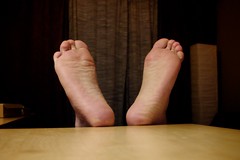Are you a daily walker, a hiker or a triathlete? Any level of intensity in your daily activities can create any of the serious and common injuries below.
Let's take care of your feet together, because healthy feet are happy feet!
Heel Pain- the most common complaint from runners caused by inflammation of the ligament which holds up the arc, known as Plantar Fasciitis
Causes:
- Plantar Fasciitis is classified as an overuse injury, the same as tendonitis. Sudden increase of activities such as going on vacation, starting a new exercise routine or changing jobs can contribute.
- Wearing non-supportive footwear on hard surfaces puts abnorman strain on the plantar fascia and can also lead to plantar fasciitis. This is particularly evident when one's job requires long hours on the feet.
- During the summer months, we see an increased number of patients in our offices with plantar fasciitis due to walking barefoot or wearing flip flops. Obesity may also contribute to plantar fasciitis.
Neuromas- A neuroma is a thickening of nerve tissue that may develop in various parts of the body. The most common neuroma in the foot is a Morton's neuroma, which occurs at the base of the 3rd & 4th toes.
The thickening, or enlargement, of the nerve that defines a neuroma is the results of compression and irritation of the nerve. This compression creates swelling of the nerve, eventually leading to permanent nerve damage.
What Causes a Neuroma?
Anything that causes compression or irritation of the nerve can lead to the development of a neuroma. One of the most common offenders is wearing shoes that a tapered toe box, or high-heeled shoes that cause the toes to be forced into the toe box.
Tendonitis- The Achilles tendon is the largest tendon in the human body and is very strong, but is also the tendon we rupture most often. Everyone who is active can suffer from Achilles tendonitis, a common overuse injury and inflammation of the tendon.
Treatment depends on the degree of injury to the tendon, but normally includes rest, which may mean a total withdrawal from running or exercise for a week, or simply switching to another exercise, such as swimming, that does not stress the Achilles tendon.
A stress fracture usually occurs in the feet and legs. They are more common in sports like running or jumping, because this type of activity forces 2-3 times the person’s body weight onto the lower limbs. The biggest symptom with a stress fracture is pain with tenderness and swelling that worsens with weight-bearing exercise.
Make sure to see a podiatrist so we can keep you active into your late, late years!








